Different Types of Lawn Grass: Identification Guide to Many Types of Sod (With Pictures)
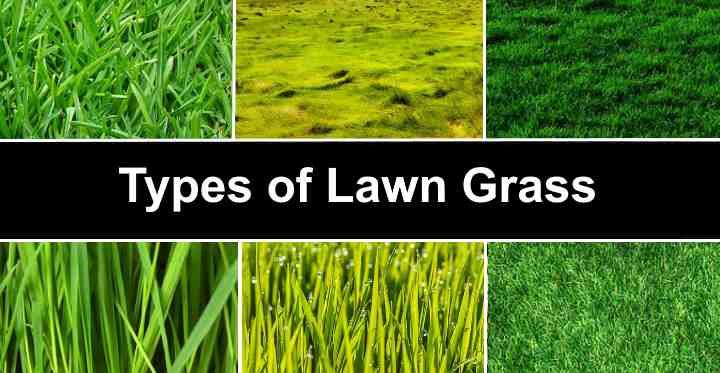
Knowing how to identify and choose the right type of lawn grass is vital to get a lush, healthy turfgrass in your yard. Different types of grass are suitable for various climates—warm-season grasses and cool-season grasses. If you need to improve the look of your garden landscape and lawn, grass identification is essential to reseed the sod with a similar type of grass.
Types of Grass
There are around 12,000 different types of grass in the botanical family Poaceae.
Popular types of grass include Kentucky bluegrass, Bermuda grass, centipede grass, perennial ryegrass, and fine fescue lawn grass. Lush green sod grass isn’t just useful for beautiful yards and gardens; hardy, robust kinds of grass are suitable for sports fields, golf courses, and parks.
What Kind of Grass Do I Have?
Identifying the kind of grass you have is done by examining the width of its blade, its shape, and the type of blade tips. You can also tell species of grass apart by their growth habit as some grass types grow in clumps. Another way to identify the type of grass is by its new shoots that grow (stolons). Some grow above-ground stems, below-ground stems or both.
Types of Warm Season Grasses (By Zone)
Warm-season grasses species are suited to Southern states in the US. Examples of warm-season grasses include centipede grass, bahiagrass, and Bermuda grass. These popular types of grass grow well in Texas, California, Florida, and Alabama. Warm-season grasses are characterized by being drought- and heat-resistant and they grow well in full sun. Warm-season grasses grow well in temperatures between 80°F and 95° (27°C – 35°C).
Features of common types of warm-season grasses:
Bermuda grass (zones 7-10)—This type of grass has tiny hairs on the blades of fine-textured, hardy grass. It’s an excellent turfgrass for sports fields and golf courses.
Centipede grass (zones 7-10)—This grass variety has thin blades of grass with a coarse texture. This slow-growing, low-maintenance grass grows well in sandy coastal regions such as the Texas Gulf Coast.
Zoysia grass (zones 5-10)—A popular type of warm-season lawn grass with good cold tolerance. The grass grows thick and green and keeps its color for most of the year.
St. Augustine grass (zones 8-10)—This heat-tolerant grass has blades of a bluish-green color and coarse texture.
Bahiagrass (zones 9, 10)—Medium to broad blades with pointed tips help identify this lawn grass. Excellent for sod or turfgrass in areas with sandy, acidic soils.
Types of Cool Season Grasses (By Zone)
Grasses suitable for cold regions are species of grass that grow exceptionally well in colder northern states. Popular types of cold season grasses include tall fescue, Kentucky bluegrass, rough bluegrass, and perennial ryegrass. Generally, the hardiest grasses for cold climates stay green even through harsh winters. The growth period for these cold-hardy grass types is in fall and spring. The ideal temperature range for cold season grasses is between 65°F and 80°F (18°C – 26°C).
Features of common types of cold season grasses:
Fescue grass (zones 4-7)—Types of fescue grass that grow in cold regions include tall fescue, fine fescue, creeping fescue, and hard fescue. The grass names also indicate something about their growth habit and appearance. These hardy grasses have broad blades and grow well in the sun or shade.
Kentucky bluegrass (zones 2-6)—Dark green turfgrass with pointed tips identify this type of grass that grows well in cold regions and the transition zone.
Perennial ryegrass (zones 3-6)—Look for thin shiny green leaves on this low-maintenance lawn grass.
Bentgrass (zones 4-6)—This is a finely-textured type cold season grass that is popular for lush lawns and golf courses. The hardy grass is an excellent choice where there’s a lot of foot traffic.
Types of Lawn Grass (With Pictures and Names) – Identification
Looking at pictures of sod or turfgrass, it’s easy to think that all grasses look the same. However, you can quickly identify individual species of grass by examining them up close. Read on to find out the botanical names of grasses, see pictures, and read descriptions of the most popular types of grass.
Bermuda Grass (Cynodon dactylon)
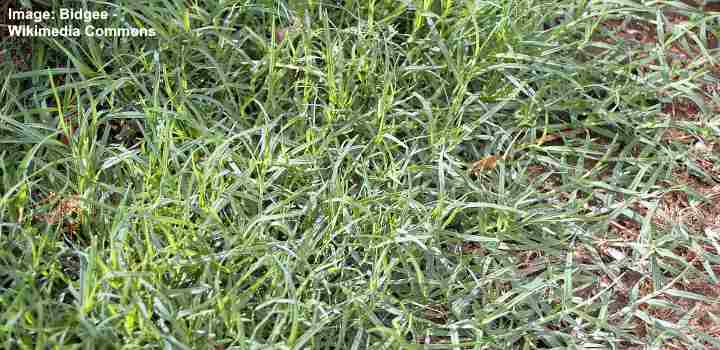
Bermuda grass sod is a hardy type of lawn grass suitable for warm regions
This warm-season perennial lawn grass also goes by the name of devil’s grass, scutch grass, and dog’s tooth grass. Bermuda grass is an excellent choice for lawns because it’s hard-wearing, resistant to heat, and withstands a lot of traffic. Even in poor soil conditions, Bermuda grass grows well. You need to plant Bermuda grass in areas with bright light and little shade. This resilient grass type needs to grow in soil with good drainage.
Bermuda grass is a grayish-green color and has short flat blades with rough edges. The deep root system gives this grass species the ability to withstand droughts. Thanks to its thick growth, it forms a dense mat of lush turfgrass.
Compared to other types of grasses for warm regions such as Zoysia grass or centipede grass, this grass variety is hardier than other types of grass for heat and drought.
Bermuda grass is a fast-growing type of grass. During the growing season, you’ll need to mow the lawn frequently.
Grass identification:
- Grass color: dark blueish-green
- Blade shape: thin blades up to 0.23” (2 – 6mm) wide
- Growth habit: spreading growth that creates thick turfgrass
Buffalo Grass (Bouteloua dactyloides)
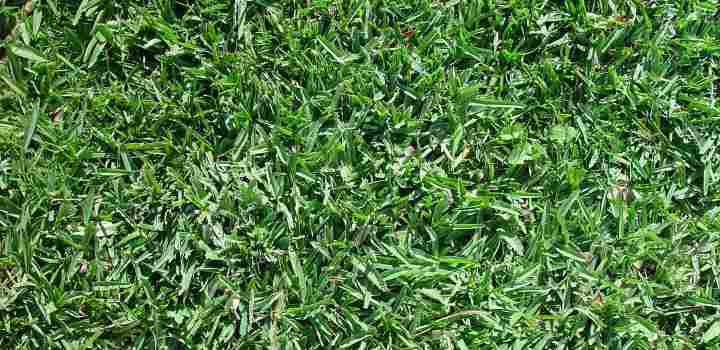
Buffalo grass is a popular type of sod in warm areas and is identified by its short blades
Buffalo grass is a warm-season perennial grass that tolerates heat and drought. This heat-hardy sod is a popular choice for lawns in California, Texas, and other southern states. The short blades of grass also mean that this type of grass is easy to care for in hot climates. However, due to its short growth, Buffalo grass tends to get weeds such as crabgrass and broadleaf weeds.
When grown as a lawn grass, buffalo grass cultivars form a fine turf. Even in low moisture areas or in drought, the turfgrass retains its blue-green color. Looking up close at the leaves, you’ll notice that they curl at the tips.
The best climate to plant buffalo grass in a yard is in high sun, low rainfall areas. High rainfall tends to cause weeds to sprout quickly. Also, the turf doesn’t grow well if there is heavy foot traffic, or it’s planted in shaded areas.
Grass identification:
- Grass color: dark blue-green
- Blade shape: curly leaves that are 0.3” to 0.35” (8 – 9mm) wide
- Growth habit: spreading growth due to runners (stolons) that form attractive turf with a thin growth
Bahiagrass (Paspalum notatum)
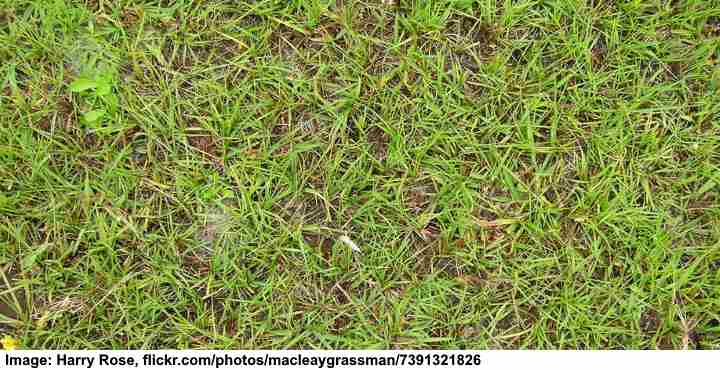
Bahiagrass is a lawn grass grown in warm areas and is low maintenance type of grass
Bahiagrass—also called common Bahia—is a warm-season perennial grass that grows in subtropical climates. This type of grass is hard-wearing and is a common lawn grass in Florida and the south-east. The sod is used where low-maintenance, heat-tolerant, and drought-resistant lawns are required. This is also a popular grass type of pastures.
Bahiagrass is a low-growing grass that spreads via creeping stolons. The result is a dense turfgrass that resists a lot of foot traffic. Grass blades are hairless and measure up to 0.23” (6 mm) wide. You can identify this grass by its flat, folded blades that taper to a point.
Similar to most warm-season grasses such as Bermuda and Zoysia grasses, this grass type is only green during the growing season. To help keep a lawn looking lush and green throughout the year, you could plant it with cool-season ryegrass.
Grass identification:
- Grass color: light green
- Blade shape: broad, folded blades that have a sharp point
- Growth habit: spreading slow growth to form thick, lush turf
St. Augustine Grass (Stenotaphrum secundatum)
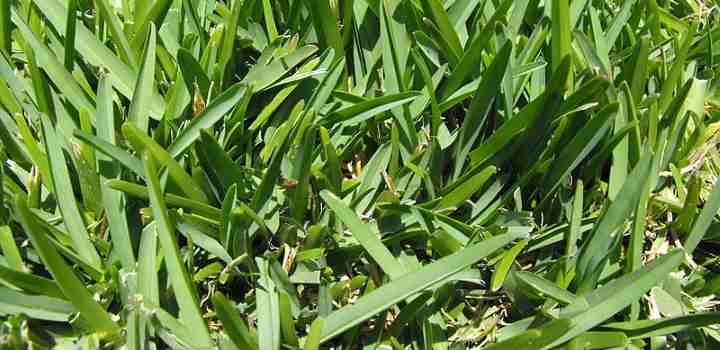
St. Augustine lawn grass is identified by its broad leaf and rounded blade tips
Another kind of grass that grows well in hot regions is St. Augustine. Growing in sunny locations, this fast-growing lawn grass quickly forms a dense mat of green. St. Augustine grass is a popular dense turfgrass in Florida and hot coastal regions because of its lush appearance. The sod also grows in a wide range of soil types, making it suitable for warm-season lawn grass in many tropical areas.
St. Augustine grass is identified by its broad, flat blades that are a dark green color. Another way to identify this warm grass type is by the blade shape that tapers to rounded tips. The broad blades measure between 0.16” and 0.4” (4 – 10mm) wide.
As a popular type of warm-season grass, St. Augustine is as popular as Bermuda grass. However, compared to bahiagrass, St. Augustine requires more maintenance, including mowing, watering, and fertilization. However, St. Augustine grass is more durable than bahiagrass.
Grass identification:
- Grass color: dark, blue-green grass blades
- Blade shape: leaves are broad and coarse, similar to centipede grass
- Growth habit: fast-growing type of tropical grass in the right conditions
Kentucky Bluegrass (Poa pratensis)

Kentucky bluegrass is common sod grass in colder and transitional areas
Kentucky bluegrass is the choice of grass seed if you want to have a perfect lawn. This cold season grass grows into lush, green dense turf with durable qualities. It is named Kentucky grass because it was a popular perennial lawn and pasture grass in the state. You may see the grass seed or sod marketed as KBG.
Kentucky bluegrass is characterized by its boat-shaped tips and narrow leaves. The grass blades grow up to 8” (20 cm) long and are about 0.12” to 0.2” (3 – 5 mm) broad with a smooth texture.
Compared to other species of grasses such as tall fescue, KBG is a slow-growing grass. It also has higher maintenance requirements than most cold season grasses. However, the depth of greenness in lush Kentucky bluegrass lawns is worth the extra work. Due to its tolerance for some heat, this Kentucky bluegrass is also an excellent lawn grass for growing in the transition zone.
Grass identification:
- Grass color: rich emerald to blueish-green
- Blade shape: flat to folded blades that are slightly curved with boat-shaped tips
- Growth habit: slow-growing grass that spreads through rhizomes
Centipede Grass (Eremochloa ophiuroides)
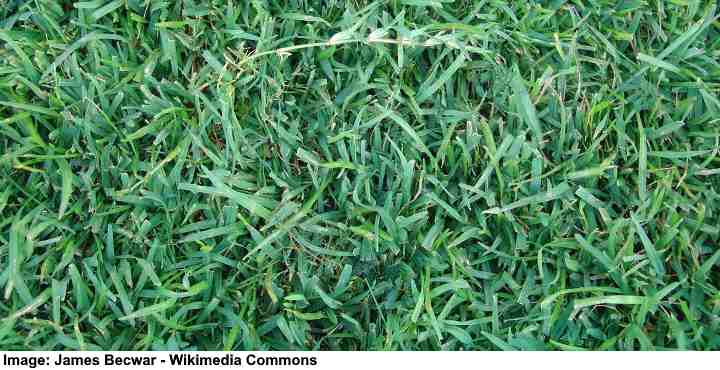
Centipede grass is a low maintenance type of grass that grown well in warm zones
Centipede grass forms thick sod that thrives in warm temperatures with very little maintenance. This dense lawn grass grows well in full sun and can also stand light to medium shade. Centipede grass is a popular grass in southeastern states with homeowners who want lush green lawns throughout the summer.
Centipede grass is a medium to light green color. You can tell this species of turf by the medium-length blades that are thin and lanceolate shaped. You can plant this grass in poor soil that is sandy or acidic. If you live near coastal areas, it is better to plant St. Augustine or Bermuda grass because those grass species are more resistant to salt.
This type of grass has been called the “lazy man’s grass” because it is easy to care for. Regular mowing and watering will help to keep the grass healthy. However, it doesn’t have such a deep luscious green color as other types of lawn grass.
Grass identification:
- Grass color: light to medium green
- Blade shape: thin, folded leaves that taper to a point or boat shape
- Growth habit: slow-growing turf grass that spreads via runners
Zoysia Grass (Zoysia)

In this grass image: Zoysia japonica ‘Compadre’
Named after a Slovenian botanist, Zoysia lawn grass is a warm-season grass that tolerates a wide range of growing conditions. This turfgrass is a popular, all-around grass that is used for lawns, golf course fairways, and other places subject to high traffic. The popular grass has a soft feel and fine texture that creates a lush, dense mat.
This versatile lawn grass creates a beautiful turfgrass in warm regions and also the transition zone. The thin grass blades grow well in full sun and are also tolerant of medium shade. Zoysia turfgrass has excellent heat and cold tolerance, which means it thrives in many climates. Being a low-maintenance lawn grass, it is the choice of sod for many homeowners.
The grass blades have a fine texture and deep green color. The thin flat blades measure about 0.07” (2 mm) wide. The turfgrass is drought-resistant and also holds up well under foot traffic. Zoysia grass has stiff leaves that form dense, lush lawns and greens. However, this grass may be more difficult to mow.
Grass identification:
- Grass color: emerald green
- Blade shape: thin blades with a rolled shape that taper to a point
- Growth habit: spreading growth and a low-growing nature
Perennial Ryegrass (Lolium perenne)
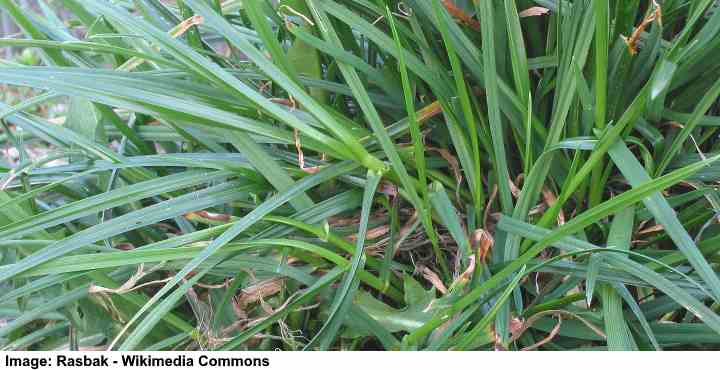
Perennial ryegrass is a popular cold season grass suitable for lawns and golf courses
As its name suggests, this lawn grass grows throughout the year and doesn’t need replanting. Perennial ryegrass is a fast-growing grass that quickly grows from seed. Other names for this grass include English ryegrass, ray grass, or winter grass. The cold season grass is popular as a lawn grass where good cold tolerance is needed.
The best type of climate for perennial ryegrass is one with mild summers and cold winters. In states of the Midwest, perennial ryegrass is one of the most popular lawn grasses. In southern states, ryegrass is the seed of choice to grow together with Bermuda grass for all year long, lush lawns.
Looking at images of the grass blades, you will notice fine ribs running the length of them. Blades are flat and gently taper to a point. Another identifying feature of perennial lawn grass is that it grows in clumps or bunches.
The fine texture of this luscious lawn grass means it’s suitable for turf where sports are played. So, this is often the species of grass used in tennis courts and golf course greens.
Grass identification:
- Grass color: medium to dark green
- Blade shape: folded at the base and flattens out
- Growth habit: quick to germinate and, once established, turf grows slowly
Fine Fescue Grass (Festuca)
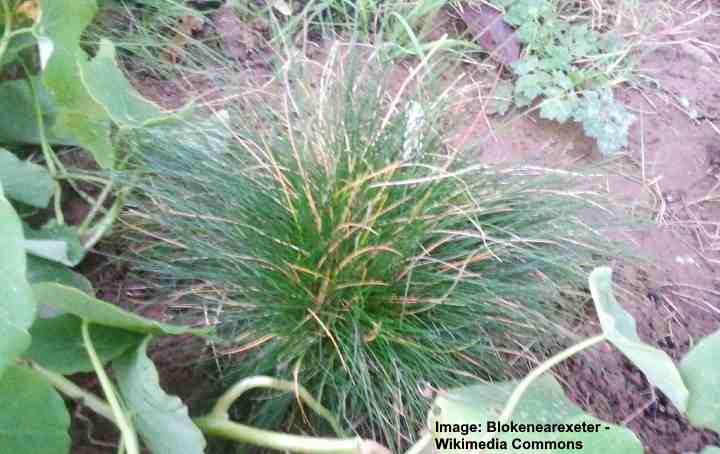
This picture shows the tufted nature of sheep fescue grass, which is a species of fine fescue grass
Fine fescue is one type of cold season grass that is a common ornamental or turfgrass. There are five species of fine fescue grasses that include:
- hard fescue
- chewings fescue
- sheep fescue
- creeping red fescue
- slender fescue
Species of fescue are used for lush lawns, sports fields, parks, and to prevent soil erosion. In North America, fescue is one of the most widespread pasture grasses for high-quality animal feed.
If you are looking for a good type of grass for a beautiful lawn, then fine fescue is a great choice. It’s one of the most versatile types of lawn grasses to grow in your yard. The hardy turfgrass grows in most soil condition, it is shade- and cold-tolerant, and doesn’t require much maintenance. Fine fescue seed is often mixed with bluegrass, Bermuda grass, or ryegrass to improve their hardiness.
Fine fescue grass has some of the narrowest blades of grass with leaves being less than 1.5 mm wide. Due to the delicate grass leaves, it’s best not to grow fine fescue grass in high-traffic areas. But the beautiful turf grass can look stunning in a well-manicured lawn as you can mow the grass to a very short height.
Grass identification:
- Grass color: medium to dark green
- Blade shape: narrow blades that taper to a sharp point
- Growth habit: bunching growth that quickly germinates then slows down
Tall Fescue Grass (Festuca arundinacea)

Tall fescue grass is characterized by its clumping growth habit and deep roots
Tall fescue grass is a cool-season perennial lawn grass that grows in a wide range of conditions. Because tall fescue grass tolerates heat, cold, drought, and shade, it is suitable for most yards. This type of turfgrass is an excellent choice for a robust, healthy lawn if you live in temperate climates. The hardiness of this sod grass comes from the fact it has a large root system—deeper than any of the other cold season grasses on this list.
The unique feature of fescue grasses that makes them so hardy is their clumping growth nature. Deep roots absorb nutrients and moisture where other species of grass can’t reach.
The difference between tall fescue grass and fine fescue is the type of blades. Tall fescue has broader leaves and is hardier than fine fescue grass. Also, tall fescue turfgrass is more robust than its “finer” counterpart and requires less maintenance. In fact, you may only need to mow your lawn once a month and just water occasionally. Some gardening experts rate tall fescue as the easiest type of lawn grass to look after.
A common tall fescue lawn grass cultivar is Kentucky 31.
Grass identification:
- Grass color: light emerald green
- Blade shape: broad leaves up to 0.5” (13 mm) wide
- Growth habit: bunch-forming hardy lawn grass
How to Choose the Best Type of Lawn Grass
To get the best-looking lawn in your neighborhood, you have to pick the best type of lawn grass. How can you know what to pick? Here are a few factors to consider when planning a beautiful lawn for your garden landscape:
- Climate—Take into consideration if you need a warm-season or cold-season lawn grass. Some species of grass sod such as Kentucky bluegrass or Zoysia Grass grow well in the transition zone.
- Foot traffic—If you need a type of hardy, durable grass, pick a species that stands up well to walking or foot traffic.
- Sunlight—Think about how much sunlight your lawn gets. Some types of sod thrive in full sunlight but won’t grow in a tree’s shade. Other varieties of grass are shade tolerant and grow well in varying conditions.
- Maintenance—Like any kind of plant, types of grasses require different levels of maintenance. Looking after a lush, green, pristine lawn can take a lot of time and effort.
As most sites are a mixture of conditions, you can also find a mixture of grass varieties or complementary grasses to improve hardiness. Sow your seed lawn mixture or seed an existing sod lawn to make it more suitable for the site conditions.
Learn how to grow a clover lawn.
Related articles:
